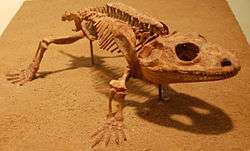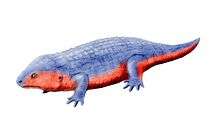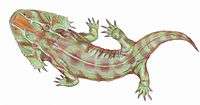Dissorophoidea
Dissorophoideans are a clade of medium-sized, temnospondyl amphibians that appeared during the Moscovian in Euramerica, and continued through to the Late Permian and the Early Triassic of Gondwana. They are distinguished by various details of the skull,[3] and many forms seem to have been well adapted for life on land. Since 2008, Lissamphibia has been progressively widely considered part of this clade,[1][4][2][5], but this position is still disputed by some authors[6][7].
| Dissorophoidea | |
|---|---|
 | |
| Skeleton of Cacops aspidephorus in the Field Museum | |
| Scientific classification | |
| Kingdom: | Animalia |
| Phylum: | Chordata |
| Order: | †Temnospondyli |
| Suborder: | †Euskelia |
| Superfamily: | †Dissorophoidea Bolt, 1969 |
| Clades | |
It is possible that the small Permo-Carboniferous Micromelerpetontidae and the large Late Permian Melosauridae may also belong in this clade.
Phylogeny
An extensive phylogenetic analysis of dissorophoids conducted in 2016 and 2018 found that the families Dissorophidae and Trematopidae are more closely related to each other than either is to the family Amphibamidae. Following a 2008 study, the Dissorophidae-Trematopidae clade was called Olsoniformes. Below is the cladogram from the 2018 analysis:[2]
| Dissorophoidea |
| ||||||||||||||||||||||||||||||||||||||||||||||||||||||
References
- Huttenlocker, Adam. 2007. Dissorophoidea Tree of Life Web Project
- Laurin, M. and Steyer, J-S, 2000, Phylogeny and Apomorphies of Temnospondyls Tree of Life Web Project (reviewed)
- Reisz, Robert (no date), Biology 356 - Major Features of Vertebrate Evolution - The Origin of Tetrapods and Temnospondyls
External links
- Dissorophoidea - Palaeos
- Dissorophoidea - Mikko's Phylogeny Archive
References
- Pérez-Ben, C.M. Schoch, R.R. & Báez, A.M. (2018) Miniaturization and morphological evolution in Paleozoic relatives of living amphibians: a quantitative approach. Paleobiology.
- Schoch, R.R. (2018) The putative lissamphibian stem-group: phylogeny and evolution of the dissorophoid temnospondyls. Journal of Paleontology. Online edition. doi:10.1017/jpa.2018.67.
- (see Laurin & Steyer, 2000, for list of apomorphies)
- Anderson, J.S. (2008) Focal review: the origin(s) of modern amphibians: Evolutionary Biology, v. 35, p. 231–247.
- Schoch, R.R. (2012). "Character distribution and phylogeny of the dissorophid temnospondyls" (PDF). Fossil Record. 15 (2): 121–137. doi:10.5194/fr-15-121-2012. ISSN 1435-1943.
- Marjanović, David; Laurin, Michel (2019). "Phylogeny of Paleozoic limbed vertebrates reassessed through revision and expansion of the largest published relevant data matrix". PeerJ. 6 (e5565): 1–191. doi:10.7717/peerj.5565.
- Laurin, Michel; Lapauze, Océane; Marjanović, David (2019). "What do ossification sequences tell us about the origin of extant amphibians?". Peer Community in Paleontology: 1–36. doi:10.1101/352609.


